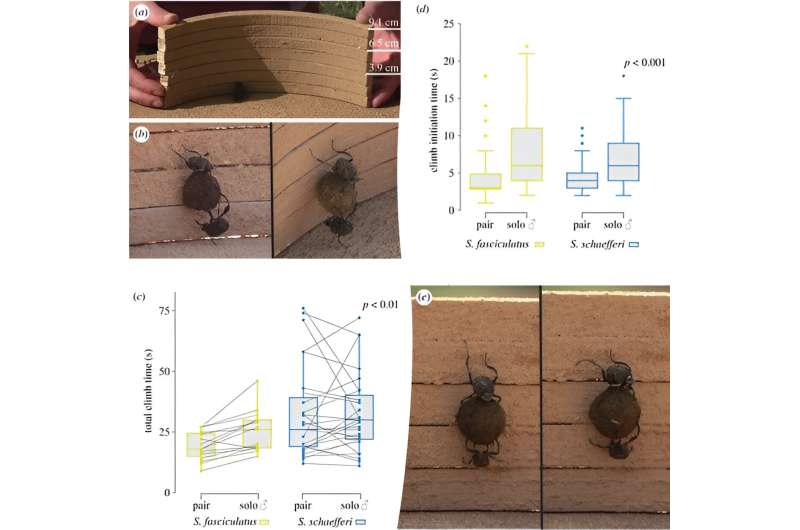January 24, 2024 report
This article has been reviewed according to Science X's editorial process and policies. Editors have highlighted the following attributes while ensuring the content's credibility:
fact-checked
peer-reviewed publication
trusted source
proofread
Dung beetles found to work together to drag dung balls over objects in their path

A small team of biologists and animal scientists from Lund University in Sweden, working with a colleague from the University of the Witwatersrand, in South Africa, has discovered that pairs of opposite-gender dung beetles work together to carry dung balls up and over objects in their path. The study is published in Proceedings of the Royal Society B,.
Prior research has shown that dung beetles forge piles of dung into balls and then roll it to a desired location not known in advance. Prior research has also shown that the reason is to move the dung to a site better for laying eggs—after the eggs hatch, the young eat the dung.
In this new effort, the researchers have found that opposite-gender dung beetles not only travel together to find dung for making into a ball, but assist one another in dragging the ball over obstructions—all without either of them knowing their ultimate destination.
In the lab, the research team found that upon finding their path blocked by a barrier such as a log or stone, the pair will take positions opposite their dung ball.
The male always climbed atop the ball and began to drag it upward. The female would place her body at the bottom of the ball, upside down, with her hind legs on the ball.
At the outset, her front legs would press against the ground. As the ball was pushed and pulled slowly upward, both the male and female would use their free limbs to climb. Upon reaching the top, they would push the ball to the ground below, on the opposite side of their initial position. From there, the male would commence pushing the ball toward its eventual destination.
The research team claims that the joint behavior is unique—only humans have ever been observed cooperating in such a manner. How the dung beetles coordinate their behavior is still a mystery, however, especially considering neither of them knows where they are going.
More information: Claudia Tocco et al, Spider dung beetles: coordinated cooperative transport without a predefined destination, Proceedings of the Royal Society B: Biological Sciences (2024). DOI: 10.1098/rspb.2023.2621
Journal information: Proceedings of the Royal Society B
© 2024 Science X Network




















